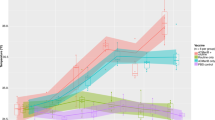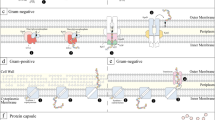Abstract
Neisseria meningitidis has several strategies to evade complement-mediated killing, and these contribute to its ability to cause septicaemic disease and meningitis. However, the meningococcus is primarily an obligate commensal of the human nasopharynx, and it is unclear why the bacterium has evolved exquisite mechanisms to avoid host immunity. Here we demonstrate that mechanisms of meningococcal immune evasion and resistance against complement increase in response to an increase in ambient temperature. We have identified three independent RNA thermosensors located in the 5′ untranslated regions of genes necessary for capsule biosynthesis, the expression of factor H binding protein, and sialylation of lipopolysaccharide, which are essential for meningococcal resistance against immune killing1,2. Therefore increased temperature (which occurs during inflammation) acts as a ‘danger signal’ for the meningococcus, enhancing its defence against human immune killing. Infection with viral pathogens, such as influenza, leads to inflammation in the nasopharynx with an increased temperature and recruitment of immune effectors3,4. Thermoregulation of immune defence could offer an adaptive advantage to the meningococcus during co-infection with other pathogens, and promote the emergence of virulence in an otherwise commensal bacterium.
This is a preview of subscription content, access via your institution
Access options
Subscribe to this journal
Receive 51 print issues and online access
$199.00 per year
only $3.90 per issue
Buy this article
- Purchase on Springer Link
- Instant access to full article PDF
Prices may be subject to local taxes which are calculated during checkout




Similar content being viewed by others
References
Schneider, M. C. et al. Functional significance of factor H binding to Neisseria meningitidis. J. Immunol. 176, 7566–7575 (2006)
Schneider, M. C. et al. Neisseria meningitidis recruits factor H using protein mimicry of host carbohydrates. Nature 458, 890–893 (2009)
Bjornson, A. B., Mellencamp, M. A. & Schiff, G. M. Complement is activated in the upper respiratory tract during influenza virus infection. Am. Rev. Respir. Dis. 143, 1062–1066 (1991)
Gentile, D. et al. Increased interleukin-6 levels in nasal lavage samples following experimental influenza A virus infection. Clin. Diagn. Lab. Immunol. 5, 604–608 (1998)
Stephens, D. S., Greenwood, B. & Brandtzaeg, P. Epidemic meningitis, meningococcaemia, and Neisseria meningitidis. Lancet 369, 2196–2210 (2007)
Cartwright, K. A. et al. Influenza A and meningococcal disease. Lancet 338, 554–557 (1991)
Schneider, M. C., Exley, R. M., Ram, S., Sim, R. B. & Tang, C. M. Interactions between Neisseria meningitidis and the complement system. Trends Microbiol. 15, 233–240 (2007)
Stephens, D. S., Spellman, P. A. & Swartley, J. S. Effect of the (α2→8)-linked polysialic acid capsule on adherence of Neisseria meningitidis to human mucosal cells. J. Infect. Dis. 167, 475–478 (1993)
Hammerschmidt, S. et al. Contribution of genes from the capsule gene complex (cps) to lipooligosaccharide biosynthesis and serum resistance in Neisseria meningitidis. Mol. Microbiol. 11, 885–896 (1994)
Tzeng, Y. L. et al. Transcriptional regulation of divergent capsule biosynthesis and transport operon promoters in serogroup B Neisseria meningitidis. Infect. Immun. 69, 2502–2511 (2001)
Uria, M. J. et al. A generic mechanism in Neisseria meningitidis for enhanced resistance against bactericidal antibodies. J. Exp. Med. 205, 1423–1434 (2008)
Ganguli, S. et al. Molecular cloning and analysis of genes for sialic acid synthesis in Neisseria meningitidis group B and purification of the meningococcal CMP-NeuNAc synthetase enzyme. J. Bacteriol. 176, 4583–4589 (1994)
van der Ende, A., Hopman, C. T. & Dankert, J. Multiple mechanisms of phase variation of PorA in Neisseria meningitidis. Infect. Immun. 68, 6685–6690 (2000)
von Loewenich, F. D., Wintermeyer, E., Dumig, M. & Frosch, M. Analysis of transcriptional control mechanisms of capsule expression in Neisseria meningitidis. Int. J. Med. Microbiol. 291, 361–369 (2001)
Johansson, J. et al. An RNA thermosensor controls expression of virulence genes in Listeria monocytogenes. Cell 110, 551–561 (2002)
Hoe, N. P. & Goguen, J. D. Temperature sensing in Yersinia pestis: translation of the LcrF activator protein is thermally regulated. J. Bacteriol. 175, 7901–7909 (1993)
Morita, M., Kanemori, M., Yanagi, H. & Yura, T. Heat-induced synthesis of σ32 in Escherichia coli: structural and functional dissection of rpoH mRNA secondary structure. J. Bacteriol. 181, 401–410 (1999)
Böhme, K. et al. Concerted actions of a thermo-labile regulator and a unique intergenic RNA thermosensor control Yersinia virulence. PLoS Pathog. 8, e1002518 (2012)
Kahler, C. M. et al. The (α2→8)-linked polysialic acid capsule and lipooligosaccharide structure both contribute to the ability of serogroup B Neisseria meningitidis to resist the bactericidal activity of normal human serum. Infect. Immun. 66, 5939–5947 (1998)
Rameix-Welti, M. A. et al. Influenza A virus neuraminidase enhances meningococcal adhesion to epithelial cells through interaction with sialic acid-containing meningococcal capsules. Infect. Immun. 77, 3588–3595 (2009)
Lijek, R. S. & Weiser, J. N. Co-infection subverts mucosal immunity in the upper respiratory tract. Curr. Opin. Immunol. 24, 417–423 (2012)
Cole, P. Recordings of respiratory air temperature. J. Laryngol. Otol. 68, 295–307 (1954)
Kugelberg, E. et al. The influence of IS1301 in the capsule biosynthesis locus on meningococcal carriage and disease. PLoS ONE 5, e9413 (2010)
Uria, M. J. et al. A generic mechanism in Neisseria meningitidis for enhanced resistance against bactericidal antibodies. J. Exp. Med. 205, 1423–1434 (2008)
Miller, J. H. Experiments in Molecular Genetics (Cold Spring Harbour Laboratory Press, 1972)
Chalmers, R. M. & Kleckner, N. IS10/Tn10 transposition efficiently accommodates diverse transposon end configurations. EMBO J. 15, 5112–5122 (1996)
Johansson, J. et al. An RNA thermosensor controls expression of virulence genes in Listeria monocytogenes. Cell 110, 551–561 (2002)
Acknowledgements
Work in C.M.T.’s laboratory is funded by Programme Grants from the Wellcome Trust and the Medical Research Council, and by the Oxford Martin School. E.L. was supported by an International Postdoctoral fellowship from the Swedish Research Council (Dnr: 524-2010-6726) and E.K. was supported by an EMBO long-term fellowship. We are grateful to J. Johansson, S. Busby and other members of the Tang group for discussions, and to B. Kallipolitis for providing E. coli 30S ribosomes.
Author information
Authors and Affiliations
Contributions
E.L., E.K., A.T., Q.Z., B.G. and H.E. performed the experiments and analysed the data. R.C. and V.P. oversaw the DNA foot-printing and construction of transcription factor mutants. C.M.T. provided overall direction, and wrote the manuscript with input from E.L., E.K. and R.C., and the other authors.
Corresponding author
Ethics declarations
Competing interests
The authors declare no competing financial interests.
Supplementary information
Supplementary Information
This file contains Supplementary Figures 1-10 and Supplementary Tables 1-2. (PDF 4042 kb)
Rights and permissions
About this article
Cite this article
Loh, E., Kugelberg, E., Tracy, A. et al. Temperature triggers immune evasion by Neisseria meningitidis . Nature 502, 237–240 (2013). https://doi.org/10.1038/nature12616
Received:
Accepted:
Published:
Issue Date:
DOI: https://doi.org/10.1038/nature12616
This article is cited by
-
Distributed genotyping and clustering of Neisseria strains reveal continual emergence of epidemic meningococcus over a century
Nature Communications (2023)
-
SARS-CoV-2 phase I transmission and mutability linked to the interplay of climatic variables: a global observation on the pandemic spread
Environmental Science and Pollution Research (2022)
-
Early warning climate indices for malaria and meningitis in tropical ecological zones
Scientific Reports (2020)
-
Recurrent wheezing in neonatal pneumonia is associated with combined infection with Respiratory Syncytial Virus and Staphylococcus aureus or Klebsiella pneumoniae
Scientific Reports (2018)
-
Community-acquired bacterial meningitis
Nature Reviews Disease Primers (2016)
Comments
By submitting a comment you agree to abide by our Terms and Community Guidelines. If you find something abusive or that does not comply with our terms or guidelines please flag it as inappropriate.



